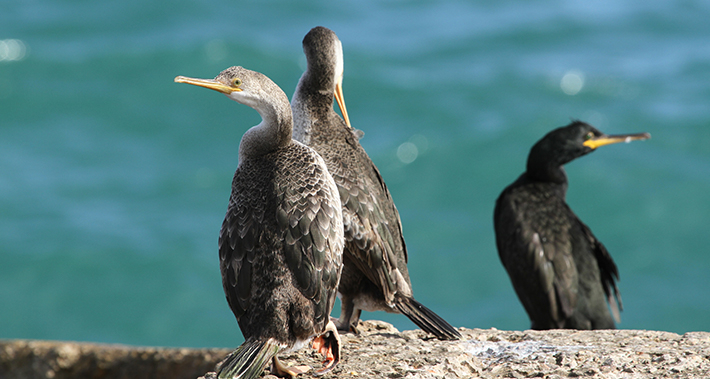Beaches as a natural space






Did you know that there is an underwater park of artificial reefs opposite Barcelona’s beaches? And that the sea beds along Barcelona’s coast area is home to organisms such as worms, snails, crabs, octopuses, cuttlefish, starfish and sand anemones? Or that a loggerhead sea turtle was recently found on Mar Bella beach? Find out all about them on this webpage.
Biodiversity
The Barcelona coastline, despite the constant transformation it undergoes as a result of human activity, hosts biodiversity that we must treasure.
What are the seabeds like?
The sandy beds host worms, sea snails, crabs, octopuses, cuttlefish, and some fish that have leant to camouflage themselves.
We find the most biodiversity on the rocky substratum, especially fish such as salps, sea bream, white sea bream, scorpion fish, red mullet, serranidae, grey mullet, and occasionally some species of ray. We can also find a large variety of invertebrates, such as starfish, sea urchins, sea cucumbers and sand anemones.
Natural heritage
Barcelona’s beaches are part of the city’s natural heritage, so we need to look after them and avoid activities that impair the water quality, and therefore the habitat of many marine organisms.
In order to help to enlarge the rocky substratum, there is an artificial reef park submerged in front of Barcelona’s beaches. The modules it is made of simulate the surfaces and holes of natural rocky seabeds and are home to diverse communities of marine flora and fauna.
The reefs, as well as encouraging the well-being of seabeds and improving artisanal fishing off the coast of Barcelona, are a very attractive area for practising environmentally friendly underwater activities.
Marine posidonia (Neptune grass) ecosystems are responsible for approximately half the storage of the world’s blue carbon, that is, the carbon that is captured and accumulated by the planet’s coastal vegetations: coastal marshland, mangroves and seagrass meadows.
In the Catalan sea, the ecosystems linked to blue carbon are quite depleted and only occupy around 92 km2.
For this reason, Barcelona City Council is encouraging the protection and enlargement of the current marine carbon gutters (mainly the seagrass meadows of Garraf and Maresme) between the municipalities of the Barcelona coastline, at the same time as rearranging the usage models of coastal areas in accordance with a policy of continuous improvement of environmental practices and prevention of coastal pollution, with the ultimate goal of maintaining the quality, biodiversity, productivity and dynamism of our sea.
In mid-July 2020 a loggerhead sea turtle (Caretta caretta) made its way from the sea to Mar Bella beach to lay its eggs. This is the first record we have of a turtle of this species choosing Barcelona to nest in.
A decision was made to allow sixty of the 77 eggs it laid to remain on the beach, roughly 50 cm deep, while the other 17 were moved to different areas to ensure the successful hatching and survival of the turtle's young.
The nest was looked after by volunteers from the Beach Centre and the CRAM until the eggs had hatched. Hatching started on 30 August 2020 and resulted in 56 baby turtles (see the news item).
After almost a year in captivity, in July 2021, 24 of the turtles hatched on Barcelona’s Mar Bella beach were released into the sea, at that very same beach. The Head Starting project, under which the animals are kept in captivity for the first year or two years of their lives, features in several marine turtle management and conservation programmes and aims to improve the species’ survival rates, which are close to 1% in the first year.
The release of the turtles, which was closed to the public for health reasons, was attended by representatives of the organisations responsible for the programme: the Catalan government, the CRAM, the CT BETA from the Universitat de Vic – Universitat Central de Catalunya (UVic-UCC), Barcelona Zoo, Barcelona City Council, and the organisations that managed the more than five hundred volunteers who had taken part in looking after the nest, coordinated by the Beach Centre: Anèl·lides, Ocean52, Oceanogami, No Mas Colillas and WWF.
Turtle nesting in the Western Mediterranean is a recent phenomenon, one that has been growing exponentially and that corresponds to the animals’ adaptation to an increasingly fast warming of traditional egg-laying areas. The loss of original beaches suitable for nesting may have an important effect on the mid-term survival of the species, which is why both the scientific community and the species’ managers consider that any nesting in these new egg-laying areas must be treated with the utmost care, and watched over to ensure their viability.
Anyone who comes across a marine turtle on the beach should call 112, the emergency telephone number, to send out an alert, and enable experts to assess the animal and the area. When the expert staff arrive, everyone else in the area should remain silent, keep to a minimum distance of 30 metres from the animal and prevent others from approaching. Do not share the location on social media. It is very important that no one touches the turtle, takes photos of it or disturbs it in any way with lights or noise.
To ensure this and any future egg-laying is successful, it is very important for everybody - citizens, volunteers and organisations - to get involved.
